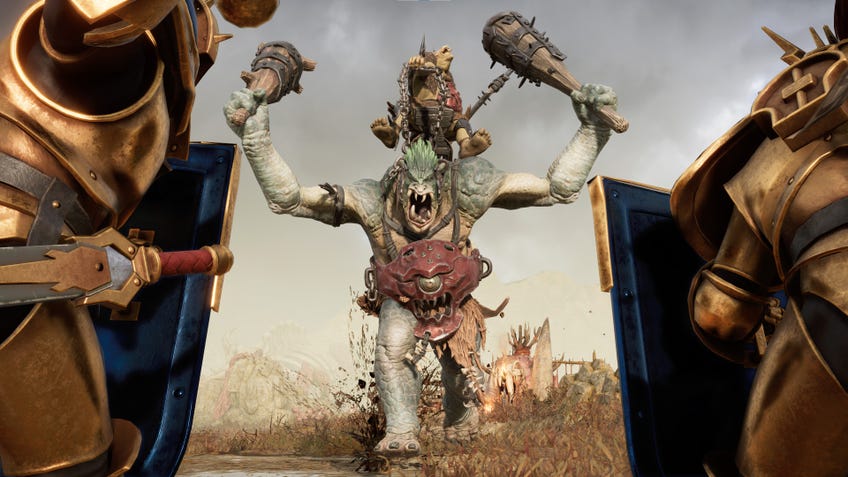“This is our dream Age of Sigmar game”: Realms of Ruin designer on staying faithful to the tabletop and why Warhammer’s Mortal Realms are the perfect setting
Principal designer Sandro Sammarco talks lore, adaptation and storytelling ahead of an open beta for the upcoming RTS.
Age of Sigmar is headed to computer and TV screens in the first real-time strategy video game based on Warhammer’s latest fantasy incarnation.
Realms of Ruin looks to use the miniature game’s Mortal Realms as the backdrop for both a single-player campaign following Stormcast Eternals leader Sigrun on her adventures across the realm of Ghur - in a story co-written by Black Library legend Gav Thorpe - and online multiplayer matches that will pit four Age of Sigmar factions against each other in direct competition.
Warhammer veterans will likely see similarities to classic Warhammer 40,000 video game Dawn of War 2 in Realms of Ruin’s focus on the unique powers of smaller squads and characters, upgradable via various tech trees, over massive armies and dozens of units.
Even so, based on my recent time with Realms of Ruin ahead of its open beta this weekend, it’s still very much its own game: a modern, newcomer-friendly RTS steeped in Age of Sigmar’s lore and character. Like my preview, the upcoming beta will give players a look at the game’s one-on-one multiplayer matches and two of its playable factions: the Stormcast Eternals and Orruk Kruleboyz.
Before that beta kicks off on July 7th, I spoke with principal designer Sandro Sammarco at Realms of Ruin studio Frontier Developments about staying faithful to Age of Sigmar’s tabletop universe, why the fantasy series has been underserved in the world of video games versus 40k, and what else we can expect from the Mortal Realms in the future.
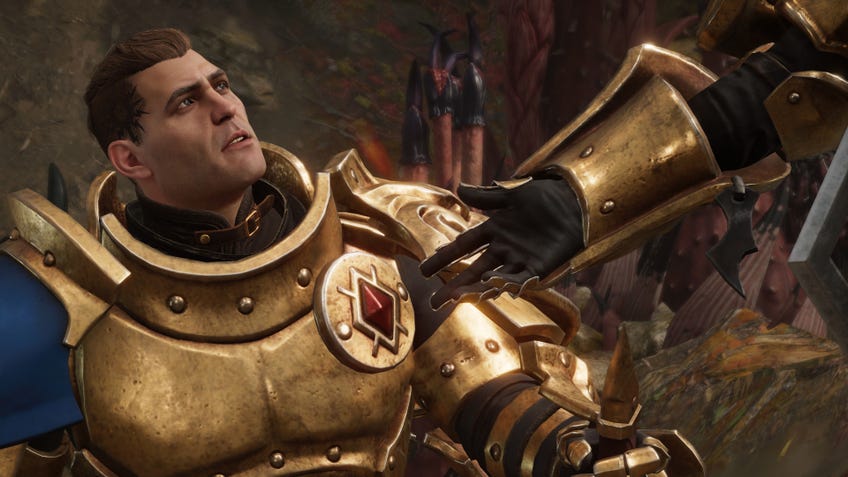
Where does Realms of Ruin fit into the existing Age of Sigmar lore as tabletop fans will know it, and what previously unseen/underexplored aspects of the universe it will explore?
Realms of Ruin is set during the Dawnbringer Crusades, which in Age of Sigmar lore is when Sigmar pushes his army into the Mortal Realms. During these Crusades, valiant expeditions strike out in the wildlands of Ghur to tame and civilise it after years of war and neglect. That was the perfect starting point for our story, and one that felt authentic to Age of Sigmar lore.
The Dawnbringer Crusades were the perfect starting point for our story, and one that felt authentic to Age of Sigmar lore.
Our campaign follows the story of one such crusade and its desperate fight for survival. In the single-player campaign, we meet a detachment of Stormcast Eternals who are dispatched by the forces of Order to establish a settlement in Ghur. But they’re in a precarious position, and under constant attack from the devious Orruk Kruleboyz who dwell in the swamps. When the Stormcast Eternals learn of a source of power that can save Harkanibus, their fortress settlement, and repel the Kruleboyz, the detachment’s leader, Sigrun, takes a chance and ventures into the swamps of Ghur to seek this power out.
What then follows is a rich narrative told from multiple perspectives about war and desperate survival.
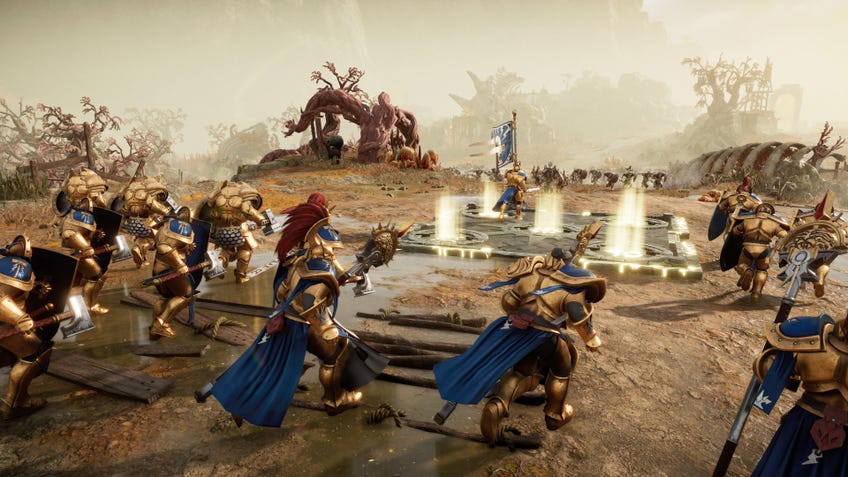
Why has Age of Sigmar been notably underserved in terms of video games compared to Warhammer 40,000, and why is now the right time for the series' first RTS outing?
I couldn’t say why there have not been many games set in Age of Sigmar, but in my opinion that makes it even more of a privilege for us to bring it to the screen in as big a way as possible. It’s a wonderfully original take on the fantasy genre.
The Age of Sigmar setting is a perfect fit for a real-time strategy game.
Age of Sigmar is a universe that we’re incredibly passionate about, and the setting is a perfect fit for a real-time strategy game. This was a great opportunity for us to tackle in our own adaptation, to bring the iconography and the intricate character models to life, and give fans of Age of Sigmar something we know they’re excited to see.
The great thing about Realms of Ruin is that you can pick it up and play it very easily if you’re new to this genre - but for RTS veterans, the skill ceiling is still high if you want to master it. That balance was crucial for us. If you want to enjoy the spectacle of Age of Sigmar in a video game, this game is here for you, no matter your experience level.
Frontier previously worked with Complex Games on Warhammer 40,000: Chaos Gate - Daemonhunters. How did tackling the high fantasy of Age of Sigmar in a video game compare to the sci-fi setting of 40k?
Luckily, for both games, we had a fantastic partner in Games Workshop, who helped us draw on the authenticity of Age of Sigmar’s lore and presentation. With such a wealth of lore on tap, Games Workshop have supported us all the way and made the experience as smooth as possible. We share the same passion for Age of Sigmar at Frontier Developments as they do - we couldn’t have asked for a better partnership!
What links Realms of Ruin and Chaos Gate - Daemonhunters is that approach to authenticity: to make sure that for each game, the visuals, the story, the gameplay design and the audio all fit players’ expectations of what excites them about those different fictional universes.
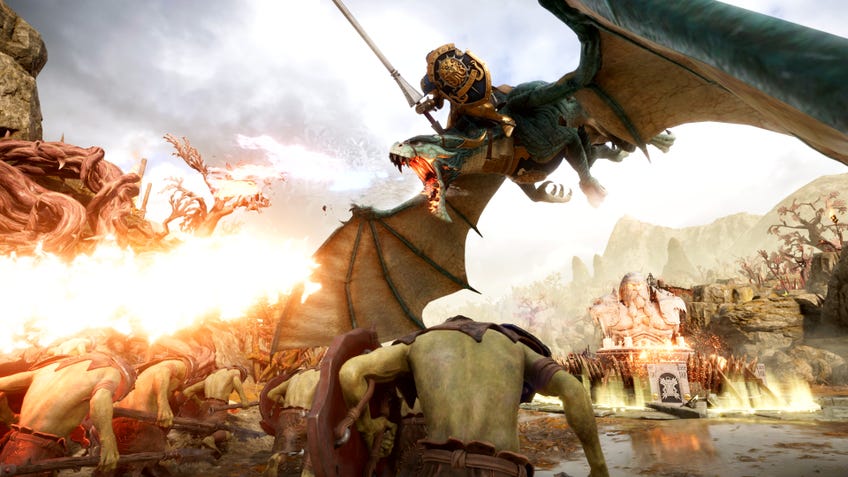
What were the biggest design and development challenges of staying faithful to Age of Sigmar’s turn-based wargaming experience in a real-time video game?
One of the biggest challenges was moving from probabilistic mechanics of the tabletop game to a deterministic RTS, without straying too far from the lore and ethos of the miniatures.
Basically, it’s about giving our players something that we wanted to see in our dream version of an Age of Sigmar game.
At the same time, it’s been a joy to explore the various warriors from Age of Sigmar and see how we can capture their essence on the battlefield. Age of Sigmar is filled with iconic factions that each have very different personalities, and we’ve captured the units in extremely granular detail through character models and animation – basically, it’s about giving our players something that we wanted to see in our dream version of an Age of Sigmar game.
The Mortal Realms is filled with compelling storylines, and this provided a great reference point to us to create a new narrative that remains authentic to the universe, and hopefully please fans when they have the chance to play it.
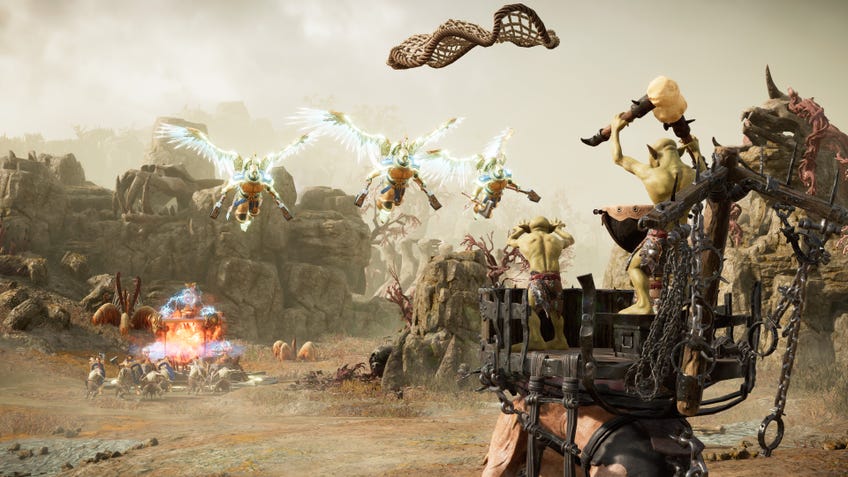
How faithful is Realms of Ruin to the tabletop game? Are models directly scanned from their miniatures?
Well, they kindly sent us miniatures, which really helped!
Our extremely talented development team worked closely with Games Workshop to use their physical and digital assets as a close reference, and this process involved lots of collaborative feedback, to create realistic, plausible, authentic versions of the factions’ different miniatures that fans will appreciate.
Hopefully, when players see Realms of Ruin in action or play it for themselves during the open beta, they’ll understand just how faithful we were to the look of the tabletop game in how we approached this project.
How did Black Library author Gav Thorpe come to be involved with Realms of Ruin’s story, and how did his experience with Warhammer help shape the game?
Games Workshop suggested that we connect with Gavin, as we always wanted to work with a writer that understood their IP. Gavin helped shape the story and the dialogue, and his involvement was crucial in creating an exciting and authentic Age of Sigmar story. We relied heavily on his expertise, given that he’s a Black Library author with a deep knowledge of the Age of Sigmar universe, and he helped us craft a story that was grounded in this lore to get the narrative element right.
Age of Sigmar is a great playground for the imagination!
What other parts of Age of Sigmar would you like to explore in the future - either in Realms of Ruin or a follow-up game - given the opportunity?
Right now, we’re focused on finishing Realms of Ruin and making it the best it can be. But obviously this IP has oodles of lore, factions and stories to explore; it’s a great playground for the imagination!

For the benefit of Dicebreaker’s readers, who know and love Age of Sigmar: we cannot wait to show off the other two factions in this game. They couldn’t be more different from the Stormcast Eternals and the Orruk Kruleboyz, and they’re incredibly cool. So, stay tuned – we have lots more to show players in the months ahead.
Warhammer: Age of Sigmar will run an open beta from July 7th to 10th, offering a preview of its 1v1 online multiplayer, ahead of the PC, PlayStation 5 and Xbox Series X|S game’s currently unannounced release date.
This interview has been edited for clarity and length.
